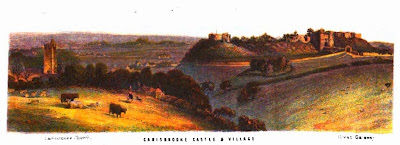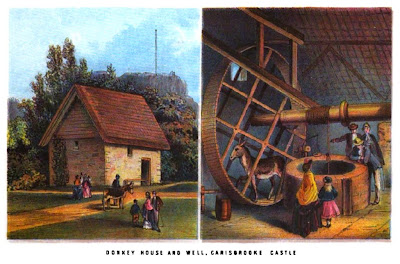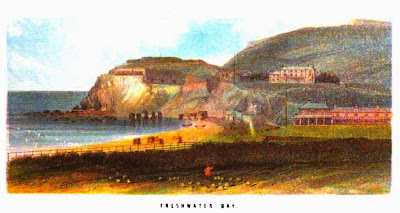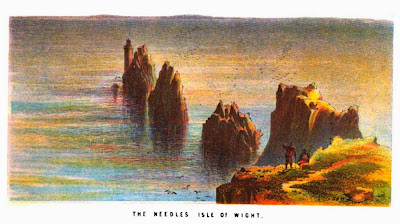"That Figure-Head." is a short story by
Mrs Harcourt Roe that originally appeared in 1901 in the London-based literary magazine
Temple Bar. I was interested to read it while researching Mrs Roe's works, but ran into problems: it's not hosted anywhere straightforward, and there's a glitch with Google Books that for some reason makes it impossible to retrieve in full, even via the usual workaround of a proxy server (Poe springs to mind: "
er lasst sich nicht lesen"). I couldn't resist the puzzle of hacking it by 'jigsaw method' from the Google Books snippet view.
I don't find much need to do this any more, as so much research material is hosted accessibly via sites such as Hathitrust, The Internet Archive and the British Library, but it can be handy on occasion. You just expand known content by using Google Books to search at the edges of a known string to find what's adjacent - and then paste it together in a word processor document as you retrieve, with format guidance from the snippet view. It can need a bit of intelligent guesswork if Google Books refuses or doesn't show the extrapolation, but for something like an article or short story, it's neither wildly laborious nor wildly time-consuming.
Anyhow, it worked, except for one page that's completely inaccessible. Maybe a broken source file is the problem? It proves, however, not to be a crucial segment. I'm 99.99% sure that the story is out of copyright.
Temple Bar was British-published, and the author Mrs Harcourt Roe died in 1913, so we're well past the "lifetime of author plus 75 years" of UK copyright. Full credits, however, go to Google, whose scan was source data for the transcription.
It's a very dark story: a claustrophobic psychological thriller aboard a becalmed ship off Central America, in a very racist era. The guilt-ridden captain, Wilson, encounters tribal magic - or it just his paranoia? - and finds himself drawn into a courtroom drama of the soul as he struggles to retain command of his ship, and of his own destiny.
“THAT FIGURE-HEAD”by A. Harcourt Roe Chapter I. The lonely bayIt was a lonely spot—horribly lonely. In the distance the high tablelands were traversed by mountain ridges, and overtopped by volcanic cones; but in the foreground there were flat oozy marshes and gigantic reeds, amongst which the water lapped sullenly. A dreadful stillness hung over the bay, which was landlocked save for a narrow entrance. The day had been sultry in the extreme, the sun—blood red—had set in a bank of grey mist. But towards midnight the haze lifted, and the stars shone out. At half-past twelve a large schooner slowly entered the bay, manned by a motley, foreign-looking crew. As they cast anchor the captain, who was a stalwart and handsome Englishman, exclaimed in a tone of alarm, “By Jove!”. For, her bow to the stern of his own vessel, lay the battered hulk of a dismasted three-decker, without a sign of life on board.
She was absolutely motionless. To all appearance To all appearance she might have been there for years; weeds encircled her hull, the anchor chain was rusted, but the figure-head, which represented a dark-skinned Asiatic, was perfect; there was not a touch of decay, apparently not even a scratch on the paint; the smooth cheeks glistened in the starlight, the dark eyes shone.
“How in the world did she come here?” exclaimed the captain.
“I suppose,” responded the chief mate, a tall, lanky, powerful American—“I suppose she has as much right to be here as we have; at the same time, it is a little awkward.”
“Santon," said the captain, " I wish I had never gone in for this cursed business. It weighs on my mind morning, noon, and night."
“But you have gone in for it, so there is an end of it. Tomorrow we must get aboard that old hulk to make sure it's all right."
“We are a great deal too close to her for safety. Should a storm come up there would be a great risk.”
"There won't be any storm to-night. I'm going to turn in; the lambs are safe enough."
As Santon spoke a noise was heard, accompanied every now and then by groans. He ran below, and then shrieks resounded in the clear air.
The captain paced the deck, his brow clouded. "I hate the whole business," he muttered, "and now I am completely in that devil Santon's power."
He looked towards the hulk. Was it his imagination, or did the eyes of the figure-head gleam? It must be the moonlight shining on them. He was getting absurdly nervous. He walked up and down, faster and faster. But at each turn his gaze was fascinated by the figure-head; he could have sworn the eyes looked into his with malicious triumph.
"By daybreak I board that hulk," he said. " Who would have thought of finding an old man-of-war in this, the very loneliest spot of Central America?”
Chapter II: The fetish manCaptain Wilson's sleep was troubled. His dreams were vivid, so vivid that in the morning he could not persuade himself that had not in the spirit visited the land of his visions.
He thought that he was in the Congo country, where every house was stuck inside and out with fetishes. There were figures of men, their bodies covered with bits of iron, feathers, and old rags, looking like scarecrows. There were red, round balls of cloth, in which the priests had sewn a strong medicine ; there were strings of poison beans, padlocks with a cowrie set in them, iron-tipped poles, birds’ beaks and claws, skins of snakes and leopards.
In his sleep Wilson was conscious that he shared the faith of these people; he believed with them that idols and talismans averted ill luck, destroyed enemies, were of sovereign power. One fetish especially attracted his attention—a horrible figure carved in the crudest style, with misshapen limbs, enormous mouth and ears, staring round eyes. He dreaded this image even more than the figure-head with the calm handsome Asiatic features. As he gazed a party of natives came forward bowing low before the horrible fetish, and finally seating themselves on the ground. A tall man now advanced; his head-dress was of feathers, snakes hung from his girdle, a necklace encircled his throat. He began to dance until frenzy took possession of him; he
…
Missing segment: page 519, where Captain Wilson, having woken from his dream of the Congo and tribal magic, rows the schooner's dinghy over to investigate the derelict ship.
...
recall whether in former days men-of-war were ever sent to these regions. The captain's large cabins looked horribly desolate; what had been chintz hangings were partly devoured by rats, the furniture was piled up in the middle as if it had been ransacked. The wardrooms and gunrooms were in even worse condition.
“Perhaps there was a storm and the crew took to the boats; perhaps the men mutinied; perhaps the ship got into this bay and could not get out again,” he mused. “Pshaw! Why should I trouble my head about what happened so many years ago?”
But his heart stood still when he suddenly heard a loud noise as of a heavy body descending on the deck over his head. A cold dew broke out on his forehead, for some one was uttering words in a dialect totally unknown to him.
He braced up his courage and called out "Who's there?"
It was Sambo, his black servant, dripping wet. He had swum from the schooner.
"Why do you dog my footsteps in this way?" asked the skipper. The black raised his arm and pointed down to the figure-head; no reply could have alarmed Wilson so much. “I will have an answer,” he said loudly.
“In my own country I fetish man.”
Leave the vessel this moment," Wilson exclaimed; "you can return in the same manner as you came, and if you go out of the schooner again without permission from me, Mr. Santon shall look after you."
He meant no empty threat; there was not one amongst the ship's company that did not dread Santon, but on this occasion the black laughed and repeated, “In my own country I fetish man.”
He jumped over the side as he spoke, and, with a sigh of relief, Wilson regained the dinghey. A few strokes of the oars brought him to his own vessel, but not before he had time to ponder over the sudden appearance of Sambo and ask himself what it meant especially in connection with his dream of the night before.
“Hullo, Captain!” exclaimed Santon, “you look uncommon gloomy. What did you see yonder?”
“Nothing at all. She is quite empty and deserted. But I will have the anchor up at once: we are too close, as I said last night; we must get away far as possible before we anchor again.”
“It will be terrible waste of work,” rejoined the chief the chief mate; “we are only here for one day to get water, and we are safe enough for the present.”
"I will have it done," returned the skipper in a tone that Santon knew admitted of no dispute, for he was now in a state of excitement and rage rare to him.
At this moment Sambo clambered up the chains and appeared at the bow, ruining the appearance of the clean deck as he shook himself like a dog.
Santon came forward and was about to use vile language, for the captain would never allow a rope's end to be used on his own servant, when to his astonishment Wilson called out, “Give him half a dozen for spoiling the look of the deck.”
The order was obeyed, although Santon said at the conclusion of the punishment, “She isn’t a dandy yacht now, skipper.”
Sambo bore the lashes in silence, but as he passed Wilson he said in a low voice, “Very good, Massa; I no forget.”
Chapter III: An awful warningThe crew went ashore, the casks were filled; the schooner would have gone on her way had this been possible. But there was not a breath of air. The haze of the day before hung over the bay, the stillness was even more brooding and intense, the heat was glaring. But in spite of the soft mist, as nightfall came on again the eyes of the figure-head began to glow and glare into those of Wilson; again the same unreasoning terror took possession of him. He called up Forbes, the second mate, who was as unimaginative man as ever lived.
“Look at that figure-head and tell me if you see anything strange about it,” said the skipper.
"The only thing I see strange about it is that it's a nigger; it's a disgrace to an English vessel to have a nigger figure-head," replied the second mate, replied the second mate, whose contempt for all coloured races was unbounded.
"It isn't a nigger, it's a Hindu. Look again!”
“One's as bad as another. No, I see nothing remarkable at all."
As he turned away Sambo came forward, whispering in the captain's ear, "Some people like log of wood, they no see, they no hear. Dog know more than he.”
He pointed to Wilson’s dog, who was trembling, his hair bristling in affright. “I tell you,” continued the man, “same devil in him as in fetish man in my country,” and once more pointed to the figure-head making some strange passes with his hands.
“I tell you what it is, Sambo,” said Wilson, speaking in low suppressed tones, “I’m sorry I had you flogged this morning, for you have been a good servant to me; but if you go on in this way I will order you four dozen, and see that you get them, too."
“If I hab four dozen four times over I say same thing,” Sambo rejoined before disappearing. Wilson looked up. He cold have sworn the eyes of the figure-head were flaming; the light reached his own as the rays of a candle reach those who regard it from a distance.
The next day the same stillness prevailed, and the next day again. More water was obtained, but the schooner could not be moved. Wilson’s nerve had now completely given way; he ordered the sweeps to be manned, and said he would leave the bay. But to this course both Santon and Forbes strongly objected.
"I know the coast," said the former, "and if there isn't a mighty storm brewing I know nothing. What chance do you suppose this craft would have on the coast outside? In here we are sheltered. Do you want to drown us all?”
So the skipper withdrew his order, but all sleep had now left him. He spent the whole of the night on deck, his eyes seldom removed from the figure-head. An uncomfortable influence pervaded the vessel ; the men, who were mostly Catholics, muttered and crossed themselves; with the exception of the mates and Sambo, all were anxious to leave the bay. And each night the same groans and shrieks resounded from below.
Chapter IV: RetributionYet one more sultry day of oppressive calm, and then came a change. Instead of being bright blue, the water assumed a dull, dark, awful hue of green and grey. It was motionless, but the colour alarmed the men ; they said it looked as if the end of the world was at hand. Even those who know the sea well seldom observe this appearance more than once or twice in a lifetime, and both Santon and Forbes were uneasy. But the captain declared that he alone would keep watch throughout the entire night, and the mates went below. The figure-head was now menacing. At last Wilson could bear it no longer. As soon as all was quiet below he dropped over the side and swam to the hulk.
His terror was so great that it gave him courage ; nothing could be worse than his present situation, he thought. He would endeavour to grapple with this demon and demand of him what he wanted.
He ascended the deck with the calm of a man who feels that he has nothing further to lose, when once more a dreadful feeling overcame him. Something—It—some unseen Power was advancing towards him.
“What do you want?” he managed to ask.
“I want from you the lives of the men you have already murdered, the lives of those men and women you are now murdering.”
“I have murdered no one,” said Wilson.
“How about the men who died during the former infamous voyages of your vessel? You murdered them as surely as if you had been on board yourself, as surely as you are know murdering those poor wretches through want of air, bad food, and cruelty."
"I abhor what I have done; I will release them," replied the skipper, the horror of that dim shapeless something overcoming him; "I have always hated what I was forced to do."
"No man is forced to do evil. Restitution comes too late; you are a doomed man. Look yonder.”
He looked. One of the volcanic mountains behind him was in eruption; there was a blaze of fire, a roar of thunder, then once more complete stillness.
"Go back whence you came,” said the awful voice. “You are a doomed man.”
Wilson needed no second command to return. He ran to the side, scrambling into the water he knew not how, and regained his own vessel. He called up the chief mate.
"Santon," he said vehemently, " I will go to the nearest port and release these poor wretches."
“And so sure as you do so I will put that forged bill into your father's hands, and I will ruin you with the girl you love and hope to marry.”
“It was for her sake I did it," returned Wilson, "because I was in difficulties, and you tempted me, like the devil you are. Whatever the consequences to myself I now withdraw, for we are, as I was told just now, murderers.”
“Who told you such rot?”
But Wilson made no reply.
“Cargo after cargo of these people have been taken and safely deposited, and are being made to work. We shall become enormously wealthy. The risk has been very great, but, allow me to remind you that although you took no part in the actual capture of the slaves and have not sailed with them before, everything has been done in your name. You are owner and master, and the law would punish you far more heavily than it would us.”
“Let it; I will do as I have said.”
“Then your name will be held up to execration throughout England; while if you hold your tongue and go on with the work you can retired in a year or two’s time as rich as Crœsus, and I will tear up the bill. I’ll do that now if you like and will promise to go on, for I know you keep your word. Your yacht came in uncommon handy and I owe you something.”
“You know as well as I do that it is illegal to keep slaves.”
“The law doesn’t come to the parts we settle in. Slaves, bless you? Hired servants, most comfortable and happy. You
shall go on.”
“I will sooner be hanged than do it,” retorted Wilson, whose courage had now returned. " I will get out of this place, and go to the nearest civilised port, set these men and women at liberty, and then and there tell all I know."
"And hanged you will certainly be."
But further parley was put an end to by a loud and awful explosion. The crew rushed on deck, the unhappy captives below shrieked. Sambo alone seemed unmoved; he stood in the bow, his eyes gleaming with joy.
The volcano was spouting into the air a column of black smoke, fire, and an immense body of stones; the sea began to be troubled, the schooner trembled in every plank. The clothes of those on deck were soon white with fine ash, which fell on deck with a noise like the sprinkling of rain. There was blue vapour from the crater, sheets of flame, then a moment of stillness.
Then a horrible phenomenon occurred. It was morning, but suddenly the vessel was enveloped in darkness. The crew, sure that the end of the world had come, sank on their knees, and began to utter such frenzied prayers as they could recall. Then a terrific cloud advanced from the sea, accompanied by a violent wind. The cloud became fiery red, thunder crashed, the lightning was awful. Rain fell in torrents, but it was no ordinary rain; it was brilliant red, and the men declared it was blood. The darkness had lifted, and on shore they could see the leaves and grass all stained crimson.
"It is because of those people that died on the voyage," said the crew; "it is their blood.” They threw themselves on the deck in abject terror, but Wilson was calm, his face was grand in its resignation. “The hour has come,” he said, “ and it is better than being hanged or imprisoned for life."
Then for a moment he thought yearningly of the girl he loved, of his old father who loved him, of his honoured name, and as he did so he glanced at the figure-head, which was calm and expressionless. The volcano was now sending forth streams of fire; with every burst loud crashes were heard. Suddenly there was a shock of earthquake, the sea began to upheave , enormous billows rolled in. The schooner broke from her moorings; she was caught in the edge of a whirlpool caused by the earthquake. Another loud crash, another violent shock, and the hulk, which had remained motionless for so long, broke loose also. Slowly both vessels began to spin round, then faster and faster. Sambo at the bow of one, the Asiatic at the bow of the other, apparently looked into one another's eyes ; the eyes of both were glowing. They were sucked further within the whirlpool, faster and faster they spun round, faster, faster still—then came a crash, and both sank into the same watery grave.
A. Harcourt Roe(Originally published in Temple Bar, Vol. 124, page 517 D, 1901).
- Ray





















































































































